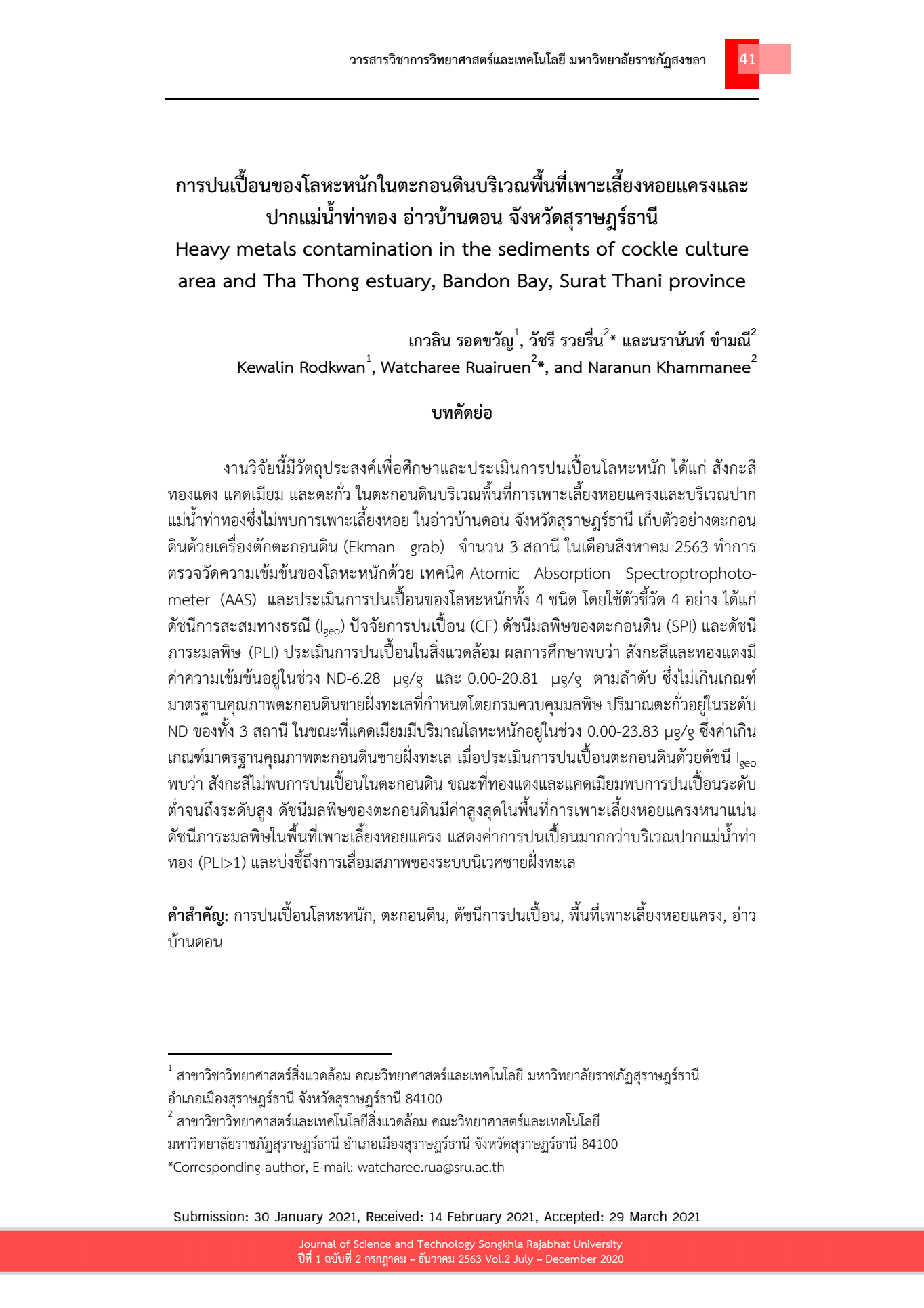Heavy metals contamination in the sediments of cockle culture area and Tha Thong estuary, Bandon Bay, Surat Thani province
Keywords:
heavy metal contamination, sediment, contamination index, cockle culture area, Ban don bayAbstract
The objectives of this research aim to determine and evaluate the contamination level of heavy metals including zinc (Zn), copper (Cu), cadmium (Cd) and lead (Pb) in the sediments collected from cockle culture and non-culture areas at Tha Tong estuary, Surat Thani province. Surface sediment samples were collected with Ekman Grab from 3 stations in August, 2020. The concentration of heavy metals were determined by Atomic Absorption Spectrophotometry (AAS) technique. The assessment contamination of heavy metal in the environment was assessed using four indicators, which include Geo-accumulation index (Igeo), Contamination factor (CF), Sediment Pollution Index (SPI), and Pollution load index (PLI). Results showed that the concentrations of Zn and Cu were in a range of non-detectable (ND) to 6.28 µg/g and 0.00 to 20.81 µg/g, respectively. These concentration levels of Zn and Cu from all three stations were not exceeding the coastal sediment quality criteria, which was issued by Pollution Control Department of Thailand. Pb reported as ND for every stations. Whereas, the concentration of Cd (0.00 to 23.83 µg/g) was over than the standard criteria. The risk analysis of Igeo indicated that the heavy metal Zn was in a range of un-contamination to moderately level contamination in the sediment. While, the Igeo values of Cu and Cd showed moderately level to high contaminated in the sediment. The highest estimations of SPI was found in the cockle culture area. The PLI values of metals in the cockle culture sediments were more contaminated than Tha Thong estuary (PLI>1), which the values was in the range indicating the degradation of the coastal ecosystem.
References
ไข่มุก ใจเหล็ก. (2561). การศึกษาอายุตะกอนดินและการสะสมโลหะหนักในตะกอรนดิน ณ พื้นที่อ่าวภูเก็ต บริเวณสะพานหิน จังหวัดภูเก็ต (วิทยานิพนธ์ปริญญามหาบัณฑิต). สงขลา: มหาวิทยาลัยสงขลานครินทร์. สืบค้นจาก https://kb.psu.ac.th/psukb/bitstream/2016/12800/1/432184.pdf
จาฤก น้อยจินดา, นิพนธ์ ตังคณานุรักษ์, และคณิตา ตังคณานุรักษ์. (2560). การเปลี่ยนแปลงปริมาณโลหะที่ปนเปื้อนในน้ำ ตามความลึกและในดินตะกอนที่ท่าเรือแหลมฉบังและท่าเรือกรุงเทพฯ ประเทศไทย. วารสารวิศวกร สิ่งแวดล้อม, 31(2), 1-13.
ซูไวบะห์ เลาะสนิง, สุปราณี ไกรรักษ์ และสุนีย์ ดาราพงศ์. (2549). การเปรียบเทียบวิธีการเตรียมตัวอย่างในการสิเคราะห์หาปริมาณโลหะหนักในหอยแครงและหอยแมลงภู่ (วิทยานิพนธ์ปริญญามหาบัณฑิต). นครศรีธรรมราช. มหาวิทยาลัยราชภัฎนครศรีธรรมราช.
ณัฐวร ขันธิกุล, เชษฐพงษ์ เมฆสัมพันธ์, ณิศรา ถาวรโสตร์, และสราวุธ ศรีทองอุทัย. (2563). การเปลี่ยนแปลงของปริมาณโลหะหนักในดินตะกอนตามฤดูกาลและพื้นที่บริเวณพื้นที่อ่าวไทยตอนใน. วารสารวิทยาศาสตร์และเทคโนโลยี, 28(10), 1739-1749. doi: 10.14456/tstj.2020.138
ทองทิพย์ วงษ์ศิลป์, จินตนา สาและน้อย, กังสดาลย์ บุญปราบ, Takashi Yoshikawa, Yuki Okamoto, และ Satoshi Ishikawa. (2559). การสะสมโปรตีนและคาร์โบไฮเดรตในดินตะกอนบริเวณพื้นที่เพาะเลี้ยงหอยแครง (Anadara granosa) ในอ่าวบ้านดอนจังหวัดสุราษฎร์ธานี. วารสารวิทยาศาสตร์และเทคโนโลยี, 24(2), 309-319.
ทิตา ดวงสวัสดิ์. (2554). การปนเปื้อนโลหะหนักในน้ำและตะกอนท้องน้ำ บริเวณปากแม่น้ำท่าตะเภา จังหวัดชุมพร (วิทยานิพนธ์ปริญญามหาบัณฑิต). พัทลุง: มหาวิทยาลัยทักษิณ
ธงชัย สุธีรศักดิ์, เพ็ญศิริ เอกจิตต์, กนกพร เมืองมูล, นูรอัสมีนา สาและ และอนัญญา ละไม. (2563). การปนเปื้อนของตะกั่ว โครเมียม ทองแดงและสังกะสี ในตะกอดินคลองปากบาง และพื้นที่รองรับน้ำทิ้ง ตำบลป่าตอง จังหวัดภูเก็ต.
วารสารวิทยาศาสตร์บูรพา, 25(3), 1181-1197.
ธงชัย สุธีรศักดิ์, เพ็ญศิริ เอกจิตต์, ณัฐรดี ชิดเชี่ยว, กนกวรรณ พงษ์กัณจน์ณิชา และเวียงชัย จงศรีรัตนกุล. (2562).
การประเมินการปนเปื้อนของทองแดง ตะกั่วและสังกะสีในตะกอนดิน คลองบางใหญ่ จังหวัดภูเก็ต. วารสาร วิทยาศาสตร์บูรพา, 24(1), 340-358.
นิภาพร รอดน้อย. (2537). การหาปริมาณโลหะหนักบางชนิดโดยวิธีอะตอมมิกแอบซอร์พชันสเปกโทรโฟโตเมตรี.
(วิทยานิพนธ์ปริญญามหาบัณฑิต). เชียงใหม่: มหาวิทยาลัยเชียงใหม่.
พจนลักษณ์ ตรีอุดม. (2559). ปริมาณสารหนูและตะกั่วในน้ำ ดินตะกอนและพืชน้ำบางชนิดบริเวณทะเลน้อย จังหวัด พัทลุง (วิทยานิพนธ์ปริญญามหาบัณฑิต). สงขลา: มหาวิทยาลัยสงขลานครินทร์.
พรพิมล เชื้อดวงผุย และเสาวคนธ์ วัฒนจันทร์. (2555). ปริมาณโลหะหนัก (ตะกั่ว แคดเมียม ทองแดงและสังกะสี) ในสัตว์ทะเลเศรษฐกิจบางชนิด บริเวณแหล่งการทำการประมง อำเภอละงู จังหวัดสตูล (วิทยานิพนธ์ปริญญามหาบัณฑิต). สงขลา: มหาวิทยาลัยสงขลานครินทร์
พิไลพร ทองมาก. (2552). การเลี้ยงหอยแครง (Anadara granosa) โดยใช้ขนาดลูกหอยและอัตราการหว่านทีแตกต่างกัน (วิทยานิพนธ์ปริญญามหาบัณฑิต). ชุมพร: มหาวิทยาลัยแม่โจ้.
เพ็ญนภา สวนทอง และ โอฬาร ถิ่นบางเตียว. (2562). นิเวศวิทยาการเมืองของการจัดการทรัพยากรชายฝั่ง ทะเลอ่าว
บ้านดอน จังหวัดสุราษฎร์ธานี. วารสารเศรษฐศาสตร์การเมืองบูรพา, 7(2), 101-132.
ภัทราวุธ ไทยพิชิตบูรพา. (2561). การประเมินสภาวะคุณภาพน้ำและดินตะกอนบริเวณอ่าวตราด จังหวัดตราด (วิทยานิพนธ์ปริญญามหาบัณฑิต). ขลบุรี: มหาวิทยาลัยบูรพา
รอฮานา อาดาม. (2562). การปนเปื้อนโลหะหนักในน้ำและตะกอนท้องน้ำบริเวณชุมชนประมงบาเละฮิเล จังหวัดนราธิวาส. Princess of Naradhiwas University journal, 11(3), 202-211.
สมทิพย์ ด่านธีรวนิชย์, สุวัฒน์ ธนานุภาพไพศาล, เจิดจรรย์ ศิริวงศ์, และอัญชลี ฤกษ์ดี (2554). การประเมินผลกระทบประเด็นปัญหาโลหะหนักในระบบนิเวศของบริเวณพื้นที่อ่าวบ้านดอน จังหวัดสุราษฎร์ธานี และการใช้หอยนางรมเป็นตัวบ่งชี้ (รายงานวิจัย). สุราษฎร์ธานี: มหาวิทยาลัยสงขลานครินทร์ วิทยาเขตสุราษฎร์ธานี.
อุดมลักษณ์ คงสังข์, ธงชัย สุธีรศักดิ์ และเวียงชัย จงศรีรัตนกุล. (2561). การปนเปื้อนของโลหะหนักในตะกอน ดิน ไส้เดือน ทะเลและหอยแครงในพื้นที่รองรับน้ำทิ้งคลองบางใหญ่ จังหวัดภูเก็ต. วารสารวิจัยและพัฒนามหาวิทยาลัย เทคโนโลยีพระจอมเกล้าธนบุรี, 41(4), 439-454.
Edresy, M. A., Wasel, S. O., & Hagibi, H. A. (2019). Ecological risk assessment of heavy metals in coastal sediments between Al-Haymah and Al-Mokha, south red sea, Yemen. International Journal of Hydrology, 3(2), 159-173. doi: 10.15406/ijh.2019.03.00177
Garson, M.S., Young, B., Mitchell, A.H.G., Tait, B.A.R., Bateson, J.H., Cogger, N., Johnson, R.L., Prewett, W.G., & Stephens, E.A. (1975). The Geology of the Tin Belt in Peninsular Thailand around Phuket, Phangnga and Takua Pa, first ed. HMSO, London.
Hakanson, L. (1980). An ecological risk index for aquatic pollution control. A sedimentological approach. Water Resources Research, 14, 975-1001.
Ho, Swennen, R. & VanDamme, A. (2010). Distribution and contamination status of heavy metals in estuarine sediments near Cau Ong harbor, Ha Long Bay, Vietnam. Geologica Belgica, 13(1-2), 37-47.
Kadhum, S.A., Ishak, M.Y., & Zulkifli, S.Z. (2015). Evaluation and assessment of baseline metal contamination in surface sediments from the Bernam River, Malaysia. Environmental Science and Pollution Research., 23(7), 6312-6321.
Keawtawee, T. & Songsangjinda, P. (2017). Heavy metal contamination In the Green Mussel Perna viridis in the gulf of Thailand. Department of Aquatic Scienc. Prince of Songkla University.
Kouchesfehani, H. S., & Azizi, S. N. (2019). Heavy Metal Pollution Assessment in Sediment of Mussel Habitats Using Geochemical Indices. Journal of Coastal Zone Management. 22(2).
Roekdee, U. (2015). Assessment of Heavy metals Impact in the Ecosystem in Bondon Bay at Surat Thani Province and Using the Oyster as a Biological Index. (Doctoral dissertation). Songkla: Prince of Songkla University
Singh, M., Muller, G., & Singh, I.B. (2002). Heavy metals in freshly deposited stream sediments of rivers associated with urbanization of the Gana Plain, India. Water, Air, and Soil Pollution, 141, 35-54.
Tomlinson, D.L., Wilson, J.G., Harris, C.R., & Jeffrey, D.W. (1980). Problems in the assessment of heavy-metal levels in estuaries and the formation of a pollution index. Helgolander Meeresunters, 33,
-575.

Downloads
Published
How to Cite
Issue
Section
License
Attribution-NonCommercial-NoDerivatives 4.0


